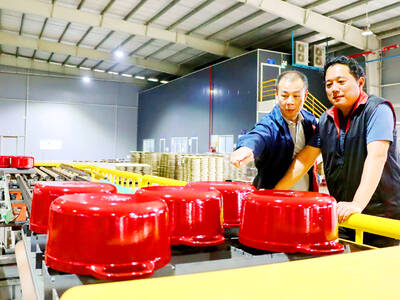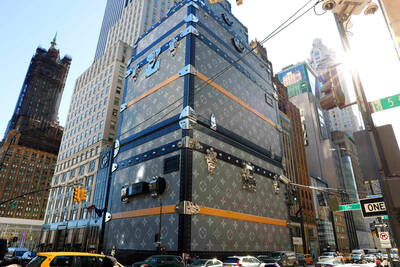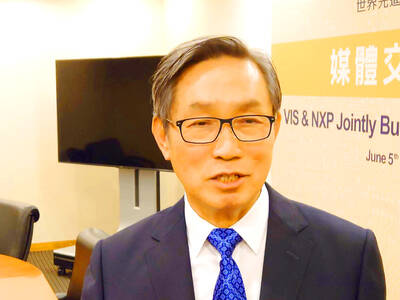Asustek Computer Inc (華碩) has delayed its annual launch of a flagship smartphone from April to July at the latest, mainly due to a quarter-long shortage in key components, company executives said yesterday.
Persisting supply constraints on key components and volatility in foreign currency exchange rates would be the two main challenges for Asustek this year, company chief executive officer Jerry Shen (沈振來) told an investors’ conference at the company’s headquarters in Taipei.
The company in November last year told reporters that it hoped to launch its next-generation ZenFone in April this year at the earliest, in an effort to maintain sales momentum, as the ZenFone 3 series product life cycle dissipates toward the end of the first half.
However, shortages in key components have affected Asustek’s plan, Shen said, declining to elaborate on the potential effect on the company’s smartphone business.
The affected components include DRAM, flash memory and flat panels that are used in both notebooks and smartphones, Asustek said.
The component shortages would increase manufacturing costs for Asustek, as component prices rise, industry analysts said.
To cope with rising manufacturing costs, Shen said the company has increased the retail prices for some of its notebook models in selected markets and also plans to hike prices for new models.
With the supply of key components tight, Asustek is to allocate their use to high-margin notebooks such as gaming and two-in-one detachable or convertible products to ensure that the company’s margins remain stable, chief financial officer Nick Wu (吳長榮) said.
Asustek forecast that the proportion of its revenues it gains from its PC business this quarter would drop to 15 percent, from last quarter’s 20 percent, while mobile business revenue would fall by between 10 percent and 15 percent due to seasonal weakness, Wu said.
Looking forward, Shen said Asustek this year hopes to ship close to last year’s 20.61 million PCs.
Revenue from the firm’s PC business is expected to grow mildly year-on-year on the back of increasing sales contributions from higher-priced gaming and two-in-one notebooks, Shen said.
The company last year reported a combined net income of NT$19.2 billion (US$624.08 million), representing NT$25.9 per share, 12 percent higher than 2015’s NT$17.09 billion, or NT$23 per share, company data showed.
Gross margin last year contracted 0.2 percentage points year-on-year to 13.6 percent, while operating margin fell 0.5 percentage points annually to 4.1 percent, the data showed.

STEEP DECLINE: Yesterday’s drop was the third-steepest in its history, the steepest being Monday’s drop in the wake of the tariff announcement on Wednesday last week Taiwanese stocks continued their heavy sell-off yesterday, as concerns over US tariffs and unwinding of leveraged bets weighed on the market. The benchmark TAIEX plunged 1,068.19 points, or 5.79 percent, to 17,391.76, notching the biggest drop among Asian peers as it hit a 15-month low. The decline came even after the government on late Tuesday authorized the NT$500 billion (US$15.2 billion) National Stabilization Fund (國安基金) to step in to buoy the market amid investors’ worries over tariffs imposed by US President Donald Trump. Yesterday’s decline was the third-steepest in its history, trailing only the declines of 2,065.87 points on Monday and

TAKING STOCK: A Taiwanese cookware firm in Vietnam urged customers to assess inventory or place orders early so shipments can reach the US while tariffs are paused Taiwanese businesses in Vietnam are exploring alternatives after the White House imposed a 46 percent import duty on Vietnamese goods, following US President Donald Trump’s announcement of “reciprocal” tariffs on the US’ trading partners. Lo Shih-liang (羅世良), chairman of Brico Industry Co (裕茂工業), a Taiwanese company that manufactures cast iron cookware and stove components in Vietnam, said that more than 40 percent of his business was tied to the US market, describing the constant US policy shifts as an emotional roller coaster. “I work during the day and stay up all night watching the news. I’ve been following US news until 3am

Six years ago, LVMH’s billionaire CEO Bernard Arnault and US President Donald Trump cut the blue ribbon on a factory in rural Texas that would make designer handbags for Louis Vuitton, one of the world’s best-known luxury brands. However, since the high-profile opening, the factory has faced a host of problems limiting production, 11 former Louis Vuitton employees said. The site has consistently ranked among the worst-performing for Louis Vuitton globally, “significantly” underperforming other facilities, said three former Louis Vuitton workers and a senior industry source, who cited internal rankings shared with staff. The plant’s problems — which have not

TARIFF CONCERNS: The chipmaker cited global uncertainty from US tariffs and a weakening economic outlook, but said its Singapore expansion remains on track Vanguard International Semiconductor Corp (世界先進), a foundry service provider specializing in producing power management and display driver chips, yesterday withdrew its full-year revenue projection of moderate growth for this year, as escalating US tariff tensions raised uncertainty and concern about a potential economic recession. The Hsinchu-based chipmaker in February said revenues this year would grow mildly from last year based on improving supply chain inventory levels and market demand. At the time, it also anticipated gradual quarter revenue growth. However, the US’ sweeping tariff policy has upended the industry’s supply chains and weakened economic prospects for the world economy, it said. “Now